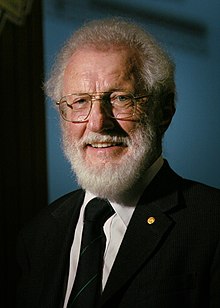
Back هربرت كرومر Arabic هربرت كرومر ARZ هربرت کرومر AZB Герберт Кромер Byelorussian Херберт Крьомер Bulgarian হার্বার্ট ক্রোয়েমার Bengali/Bangla Herbert Kroemer Catalan Herbert Kroemer Czech Herbert Kroemer Danish Herbert Kroemer German
Herbert Kroemer | |
|---|---|
 Kroemer in 2008 | |
| Born | August 25, 1928 |
| Died | March 8, 2024 (aged 95) |
| Nationality | Germany United States (from 2003)[2] |
| Alma mater | University of Jena University of Göttingen |
| Known for | Drift-field transistor Double-heterostructure laser Heterojunction bipolar transistor |
| Awards | J J Ebers Award (1973) Humboldt Research Award (1994) Nobel Prize in Physics (2000) IEEE Medal of Honor[1](2002) |
| Scientific career | |
| Fields | Electrical Engineering, Applied Physics |
| Institutions | Fernmeldetechnisches Zentralamt RCA Laboratories Varian Associates University of Colorado University of California, Santa Barbara |
| Thesis | Zur Theorie des Germaniumgleichrichters und des Transistors : Ausz. Mit 10 Fig. im Text (1953) |
| Doctoral advisor | Fritz Sauter |
Herbert Kroemer (German: [ˈhɛʁbɛʁt ˈkʁøːmɐ] ⓘ; August 25, 1928 – March 8, 2024) was a German-American physicist who, along with Zhores Alferov, received the Nobel Prize in Physics in 2000 for "developing semiconductor heterostructures used in high-speed- and opto-electronics". Kroemer was professor emeritus of electrical and computer engineering at the University of California, Santa Barbara, having received his Ph.D. in theoretical physics in 1952 from the University of Göttingen, Germany, with a dissertation on hot electron effects in the then-new transistor.[3] His research into transistors was a stepping stone to the later development of mobile phone technologies.
- ^ "Herbert Kroemer". IEEE Global History Network. IEEE. Retrieved 10 August 2011.
- ^ Yang, Henry T. (12 March 2024). "Sad News – Professor Emeritus Herbert Kroemer". chancellor.ucsb.edu. University of California, Santa Barbara. Retrieved 6 October 2024.
- ^ Kroemer, Herbert (1953). Zur Theorie des Germaniumgleichrichters und des Transistors : Ausz. Mit 10 Fig. im Text (PhD). University of Göttingen. OCLC 73916980.